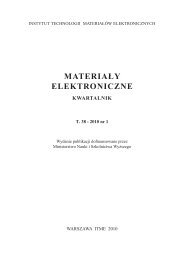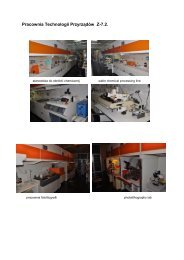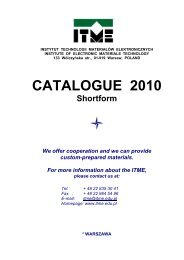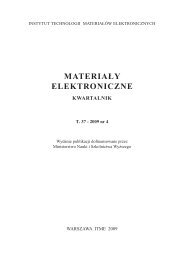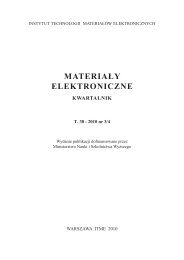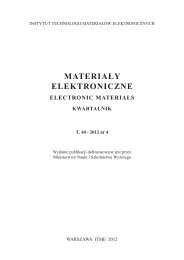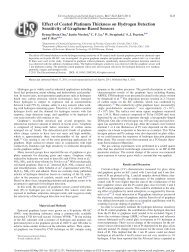Nr 1 - ITME
Nr 1 - ITME
Nr 1 - ITME
You also want an ePaper? Increase the reach of your titles
YUMPU automatically turns print PDFs into web optimized ePapers that Google loves.
Supercapacitors in stand-alone PV systems with ...<br />
1. INTRODUCTION<br />
Supercapacitors as the components extensively used in contemporary power<br />
engineering begin to play more and more important role because of their certain<br />
parameters, which cannot be imitated by other known electric devices. The main<br />
properties of the supercapacitors are connected with their very low internal resistance<br />
as the energy source, which also enables fast charging processes when using very<br />
high instantaneous current values. In comparison with even the best battery types,<br />
the supercapacitors may withstand up to a million full charging/ discharging cycles,<br />
which is ten times more than in case of the popular lead acid batteries. The most<br />
significant feature of the supercapacitors is their extremely large electric capacity,<br />
exceeding several thousands of Farads per unit at rather very low working voltage<br />
of the order of 3 volts. As a rule, this voltage of little practical use can be increased<br />
by connecting in series several supercapacitors, possibly of the same capacitance,<br />
thus creating the series capacitor bank. The resulting value of capacity of the bank<br />
decreases n times, while the working voltage increases n times, where n is the<br />
number of supercapacitor units. This common method appears not to be simple<br />
in practice owing to certain safety measures and devices necessary to realise such<br />
series connections. Like in case of the batteries, it is not advisable to connect the<br />
supercapacitors in parallel in order to increase the capacity and stored energy.<br />
The properties of supercapacitors, resembling those of conventional batteries<br />
and often much better, make them suitable for energy storing in some PV systems,<br />
as battery replacement. The maintenance-free and durable supercapacitors, though<br />
still expensive as the novel market products, may appear irreplaceable in certain<br />
types of PV systems for special applications, where the battery weight and system<br />
size offering similar effects from an energy standpoint would be less efficient and<br />
much more expensive.<br />
Another interesting option is the energy storing unit, made of a battery and<br />
a supercapacitor connected in parallel, offering more significant reduction in the<br />
battery size and weight.<br />
Generally the most appropriate application for a charged supercapacitor is utilising<br />
its energy in form of periodical instantaneous high power pulses, sufficient<br />
for generating the necessary amount of energy. Here, the welding process carried<br />
out periodically can be given as an example of the most typical application. Such a<br />
process is typically characterized by the very high power pulses of short duration,<br />
while the average welding power consumption is several orders lower compared to<br />
that delivered by even a small PV system. Similar effects characterise the pulsed<br />
laser devices, radar equipment, blinking warning light sources, sea signalling buoys,<br />
temporary radio pulsing signals etc. At present, very many solutions, though not<br />
purely pulsed-type, are applied in automotive engineering.<br />
108





